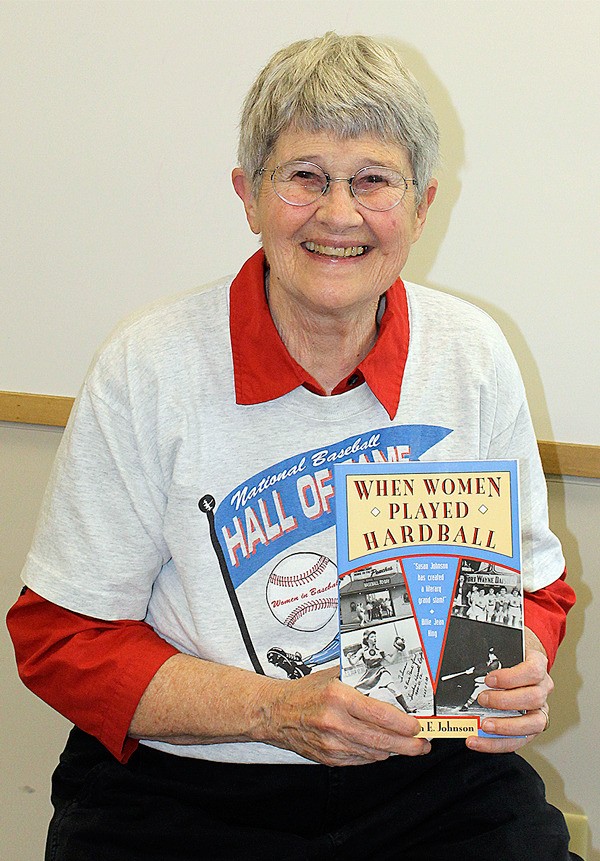To the people of Rockford, Ill., the Rockford Peaches were true all-American hometown heroes.
Nearly every game the all-women’s baseball team played was well-attended by a bevy of dedicated fans, with Susan Johnson among the most devout.
Johnson, a self-described “tomboy” and Rockford native, first met her girlhood heroes at age 10, in 1950, when her parents took her to her first Rockford Peaches baseball game.
It was a pivotal experience for Johnson. The Peaches were not only impressive athletes and formidable opponents on the field. For her and others, the Peaches symbolized women’s ability to do anything, and “do it with excellence.”
The Peaches were a member of the All-American Girls Professional Baseball League, which existed from 1943-1954. The league was the first women’s professional team sports league in the United States.
“For a long time, their history was the history of women’s professional team sports,” Johnson said.
Until the league folded in 1954, Johnson regularly attended games, fan picnics and other Peaches events and kept a scrapbook filled with photos, autographs and newspaper clippings.
Through several years and numerous moves, Johnson’s two boxes of Peaches memorabilia have remained in her possession, a reminder of that remarkable era.
When Johnson celebrated her 50th birthday, she said she came to the realization that the players she’d so admired were much older than her.
“If I was ever going to do anything to honor them, I should get busy and do it,” she recalled thinking.
She spent the next two years seeking out and interviewing each of the 26 players from the Fort Wayne Daisies and Rockford Peaches, the two teams to play in the 1950 league championship, as well as one coach.
The result, a book entitled, “When Women Played Hardball,” is the only book written about the league to be penned by a fan who watched them play.
Johnson will be reading from her book and autographing copies at 3 p.m. Monday, Oct. 26, at Regency on Whidbey. It is one of two readings to be held as part of Regency’s Arts and Letters Forum this fall. On Nov. 13, Ann Barker Holland will be reading from her memoir “Leaving Sixberries: Finding the Missing Pieces,” which describes her childhood in WWII England and subsequent emigration to the United States. At each reading, refreshments will be served, including peanuts and Cracker Jacks and English tea, respectively.

“It was very exciting,” Johnson said emphatically of meeting the players. “They had been my heroes. And when I went back 40 years later, it was as though they were still my heroes.”
To each interview, Johnson brought along her scrapbooks.
“They just loved it that a fan was returning to interview them,” she recalled.
The league had been founded by major league baseball executives who were concerned that the 1943 baseball season might not come to pass as America had just entered WWII, and the majority of men were abroad. As they did in many formerly male-dominated industries, women stepped up to the plate. Though men’s major league baseball did continue in 1943, the women, having already been recruited, carried on in a league truly their own.
In that first year, the league contained four teams. At its peak in 1948, there were 10.
The game was a hybrid of softball and baseball, though more closely resembling the latter, Johnson said, especially in later years.
“I have no idea why everyone doesn’t play baseball,” she said. “Everyone is always afraid women are going to get hurt, so somehow softball sounds less dangerous.”
The athletes were recruited from the U.S., Canada and Cuba, with the initial tryout at Wrigley Stadium.
League owners, Johnson said, expected audiences of the era would prefer to see feminine women on the field. The women were required to wear lipstick, and attended charm school as a part of spring training.
“They were supposed to look like girls and play like men,” Johnson said of the athletes.
“To the credit of the owners, instead of taking beautiful women and trying to teach them how to play baseball, they took women who already knew how to play baseball and dolled them up,” she added.
The teams played in mid-size midwestern towns surrounding Chicago, and though famous in their communities, were not well-known nationally until the premiere of the film “A League of Their Own” several years later.
For many years, the league held the title of the longest-running women’s professional team sports league. It was only fairly recently surpassed by the National Women’s Basketball Association.
It’s a point of sociological curiosity to Johnson, who speculated as to why women’s team sports hadn’t become as established as quickly as women’s individual sports. In part, she said, the reason may have been financial — it’s easier to support one person, rather than many. “But I also think there’s something about women in groups that scares people,” Johnson said with a laugh. “Women all by themselves, that’s OK.”


